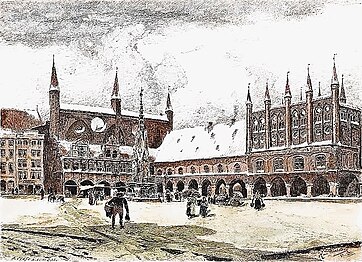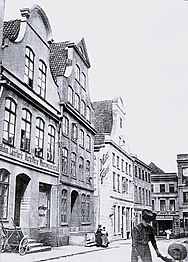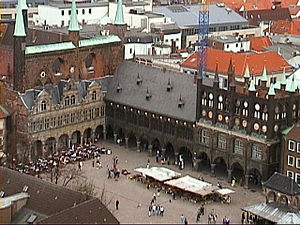Market (Lübeck)
The market is the first place in the Hanseatic City of Lübeck .
history
Excavations in the late 1990s uncovered seven layers from different times, indicating that the market was in continuous use. In addition, Roman ceramics were found hidden in shafts. It is believed that these could be offerings from prehistoric times. That the place already held a special meaning in early history can be inferred from the writings of the chronicler Helmold von Bosau from 1156, where he mentions that pagan tribes had held their thing here .
In the Middle Ages, retail was only allowed in the market area between the upper Mengstrasse and the Kohlmarkt and the Schüsselbuden up to the Breite Strasse . In 1290 there were 322 stalls on the market. Market justice was extended to the entire urban area at the end of the 13th century. The market was completely rebuilt in the first half of the 14th century, initially partially with wooden buildings, which were gradually replaced by solid buildings with a basement.
The former trading houses opposite the Marienkirche , which were remodeled in the 18th century , represented the actual edge of the market. Only the Gothic cellar of No. 2 has been preserved (see here ).
On the afternoon of June 18, 1871, the people of Lübeck received their military returning home victorious from the war for the last time . Coming from Beckergrube , it moved up Breite Straße , past the one above Mengstraße designed by the architect Max Grube Jr. created victory column on the market. On the side of the renaissance pavilion was the spectator stand , on the speaker's podium, where it was received by the incumbent mayor Heinrich Theodor Behn after the senior Johann Carl Lindenberg , "Honor to God, salvation to the fatherland, thanks to the warriors". Together with the more delicate singers' platform in front of the council scales , it formed the framework for a square in the middle of the square for the formation of the troops and their trades. When they arrived, they were greeted with the singing prayer composed by Müller von der Werras and set to music by Franz Abt .
Under the leadership of Eduard Kulenkamp , the Society of Friends of Art succeeded in “liberating” Lübeck from the Uechtritz Kaiser Wilhelm monument , which was originally intended for the market. Kulenkamp's merit in this was undeniable. When the new commission on the building regulations for an imperial monument was appointed, he was recognized for this merit by being appointed to the commission.
The regiment returned home at the central station on the morning of November 26, 1918, coming from guard duty during the transition period around Strasbourg in Alsace-Lorraine . In the official celebration on November 30th, Mayor Fehling as representative of the Senate, Dimpker as spokesman for the citizenship, Retyfeldt as member of the soldiers 'council and the editor Stelling as representative of the workers' council welcomed the regiment that had returned. However, only remnants of this were left. His officers had already left the regiment. Since Hauss was ill, the commander of the command of the 81st Infantry Brigade , also located in Lübeck , Colonel Hans von Werder , thanked them on behalf of the regiment.
Entry of the victorious battalion on June 18, 1871 by Johannes Nöhring
Town hall with market place in 1881 by Hans von Bartels
Former Reichspost building on the market
Market around 1905 with the neo-Gothic fountain
Development and further history
The market is closed to the northeast by the angular structure of the town hall , which visually separates it from the pedestrian zone of the Breiten Straße behind it , although there is a connection through the arcades of the town hall within walking distance. The Ratskeller zu Lübeck under the town hall has been used as a Ratskeller since 1220. Despite the war damage caused by the air raid on Lübeck on March 29, 1942 and a reduction in size to the south during the reconstruction of the inner city , the market in front of the mighty backdrop of the Marienkirche still looks almost like old views. The Kaak , a medieval court arbor and pillory , was demolished and stored after the war in 1952; In 1986 it was rebuilt a little to the north using old components. The neo-Gothic post office closing the market to the west was initially given a simpler facade in the 1950s and was demolished after the post office moved out in 2003 and replaced in 2005 by a modern department store by the architect Christoph Ingenhoven . The money was not enough to rebuild the town house, which was demolished on this occasion, so that the northwest corner shows up as unused open space. The market fountain , built in 1873, was demolished in 1934 as the market was used as a parking lot until the early 1980s.
The Kaak, which was rebuilt in 1986/1987 using Gothic buildings
use
One of the Lübeck Christmas markets takes place on the market in the run-up to Christmas . A relief image for the blind / unfamiliar with the area is on the edge of the market.
Kohlmarkt
Main article: Kohlmarkt (Lübeck)
The Kohlmarkt adjoins the south bar of the market development . It got its name from the Middle Ages , because at that time kiln coal was sold there (and not cabbage, as is often mistakenly assumed). However, its space function does not come into play today because at first sight it is only a major stop for Lübeck's city traffic . From the Kohlmarkt, Holstenstrasse leads down the Altstadthügel to the Trave and over the Holstenbrücke in the direction of the Holsten Gate to the west out of the old town. According to Wilhelm Brehmer's interpretation , the Kohlmarkt could have run on both sides of Holstenstrasse. Together with Wahmstrasse and Holstenstrasse, Kohlmarkt forms the only east-west connection in Lübeck's old town and Sandstrasse forms the south-west connection and is therefore an important route for public transport .
To the west of the market, the Schüsselbuden connects the Beckergrube and Mengstrasse with the Kohlmarkt and Holstenstrasse.
literature
- W. Brehmer : The street names in the city of Lübeck and its suburbs. HG Rathgens, Lübeck 1889.
- Wolfgang Erdmann: The formation of the Lübeck squares in the 12th and 13th centuries as well as comments on their iconology. In: Journal of the Association for Lübeck History and Archeology . 71, 1991, p. 9 ff., With reference.
- Peter Guttkuhn: The Lübeck Kaak. In: Father-city sheets. 27. Vol., 1976, ISSN 0724-1410 , p. 61.
- Rolf Hammel-Kiesow : Market. In: Antjekathrin Graßmann (Ed.): Lübeck-Lexikon. Schmidt-Römhild. Lübeck 2006, ISBN 3-7950-7777-X , pp. 256-257.
See also
Web links
Individual evidence
- ↑ The celebration of the homecoming of Lüb. Fusilier battalions on June 18 and 19 In: Lübeckische Blätter , 13th year, No. 50, edition of June 21, 1871, pp. 281-282.
- ↑ The celebration of the homecoming of Lüb. Fusilier battalions on June 18 and 19 In: Lübeckische Blätter , 13th year, No. 51, edition of June 25, 1871, pp. 285-292.
- ^ Association of Art Friends. In: Lübeckische Blätter ; Volume 67, number 6, edition of February 9, 1902, p. 68.
- ^ The homecoming of the Lübeck regiment. ; In: Vaterstadtische Blätter ; Born 1918/19, No. 5, edition of December 8, 1918, pp. 17-19.
- ↑ The model was shown in the opening credits of the mystery television series 4 gegen Z , which was first broadcast in 2005 . Behind him stood Zanrelot , who let the audience know that Lübeck was his.
- ^ The street names in the city of Lübeck and its suburbs , Lübeck 1889
Coordinates: 53 ° 51 '59.7 " N , 10 ° 41' 5.7" E









